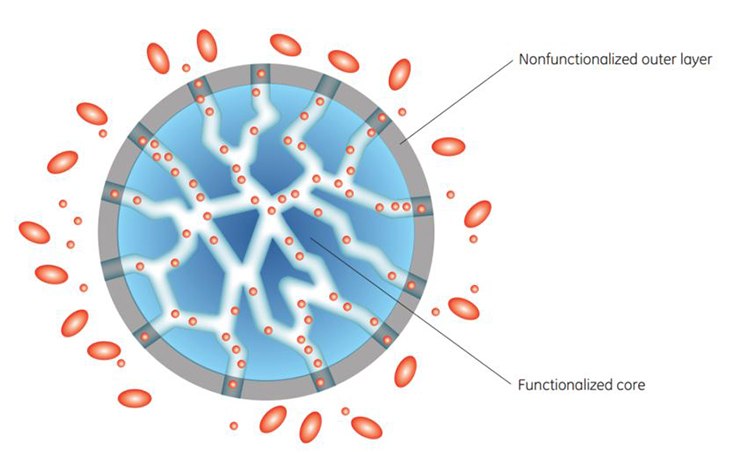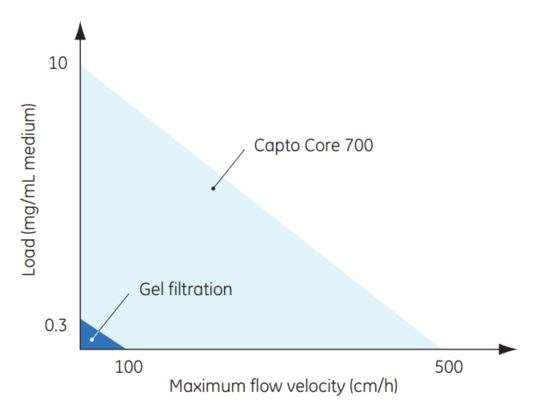Capto Core 700
Capto Core 700 is designed for intermediate purification and polishing of viruses and other large biomolecules in flowthrough mode.
Designed for flowthrough chromatography The Capto Core concept is based on a bead with an nonfunctionalized outer layer (without ligand) and a functionalized core with an attached ligand (Fig 3.14). This design combines properties of GF and adsorption chromatography. The bead’s pores in the outer layer, with an approximate exclusion limit of 700 kD, have been specifically designed to exclude large molecular entities such as viruses, DNA, large protein, or protein complexes from entering the internal space and interacting with the ligand, thereby enabling an efficient flowthrough purification step.

Figure 3.14.Schematic cross-sectional view of a Capto Core 700 particle with an average diameter of 85 μm. Small protein impurities can enter the interior of the matrix particle and bind to the ligand. Large molecular entities such as virus particles are hindered from entering the matrix.
The core of each bead is functionalized with octyl amine that is both hydrophobic and positively charged (at pH < 10), resulting in a highly efficient multimodal binding of various impurities over a wide range of pH and salt concentrations. This novel core bead technology gives Capto Core 700 a dual functionality, combining size separation and multimodal binding. These features make Capto Core 700 an excellent alternative to size exclusion media that are typically employed in the final stages of virus purification in vaccine manufacture (see Heyward et al. [1977]; Nayak et al. [2005]; and Kalbfuss et al. [2008]). Capto Core 700 offers a range of performance advantages over GF, which is often regarded as a productivity bottleneck in the polishing process due to low flow rates and limited sample loads. The characteristics of Capto Core 700 are summarized in Appendix 1 (Characteristics of multimodal chromatography media).
Key performance characteristics of Capto Core 700 include:
- significantly improved productivity enabled by up to 100-fold higher sample load and significantly higher flow rates compared with GF
- core bead technology with ligand-activated core and inactive shell allowing efficient capture of impurities while target molecules are collected in the flowthrough fraction
- straightforward optimization due to flowthrough chromatography and robust performance allowing for a wide window of operation For a more detailed description of the use of Capto Core 700, see Chapter 4 (Purifcation of influenza A/H1N1 using Capto Core 700).
Improved productivity
The core bead technology in Capto Core 700 enables high loading capacity during group separation of molecules. The core bead technology also allows for short residence times (sometimes as low as 1 min), and in combination with the large 85 μm high-flow agarose matrix, flow velocities as high as 500 cm/h are possible. The short residence times, high flow velocities, and high loading enable a larger operational window than traditional GF. The larger operational window allows for increased volume throughput and smaller equipment with reduced footprint. The large bead size also contributes to reducing back pressure during purification of highly viscous samples. The improved window of operation provided by Capto Core 700 allows greater freedom of process design.
Figure 3.15 illustrates schematically the higher load capacity and flow velocities enabled with Capto Core 700 relative to that of Sepharose 4 Fast Flow, which is a GF medium typically used in large-scale polishing processes.

Figure 3.15.Schematic illustration of the significantly greater sample load and flow velocity enabled with Capto Core 700 in comparison with conventional GF media. Note that the schematic is not to scale.
Regeneration
Bound impurities are removed from the beads by CIP procedures (see Appendix 2, Maintenance of media and storage conditions, for maintenance of the medium).
Materials
如要继续阅读,请登录或创建帐户。
暂无帐户?